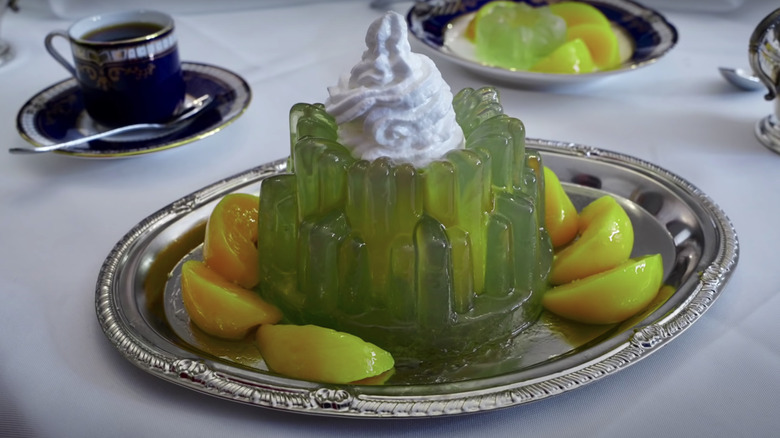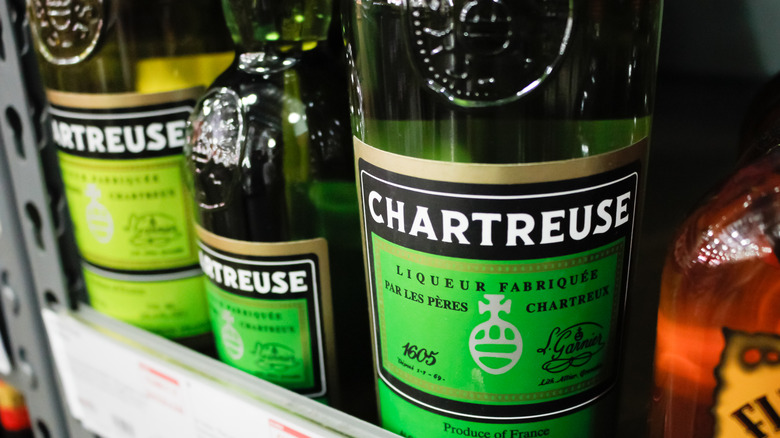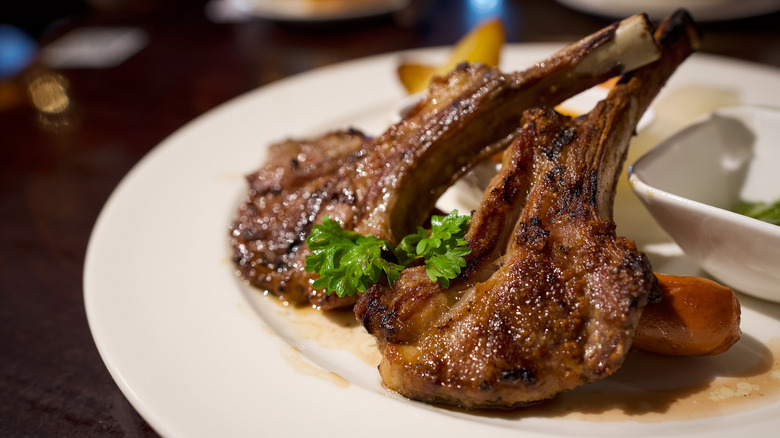The Last Dessert On Board The Titanic Was A Boozy, Gelatinous Mess
When we describe the RMS Titanic's final dessert as a boozy, gelatinous mess, we're not criticizing the chef. We're actually referring to a specific dish that was part of the 10-course Titanic dinner on April 14, the very night the legendary luxury ocean liner tragically sank after colliding with an iceberg in 1912.
The dessert in question was a peaches and Chartreuse jelly. The standout ingredient was Chartreuse, an herbal French liqueur crafted by Carthusian monks in the 17th century. This spirit is distinctively green — so much so that its name later denoted a specific shade of neon green. With its hint of mint and its status as a luxury item, Chartreuse was deemed worthy of inclusion in the first-class menu of the Edwardian Era.
Visually, the dessert was defined by its wobbly, gelatin-like consistency. However, it wasn't haphazardly presented — especially not on the Titanic, where it was likely intended as one of the visual showpieces of the entire meal for its striking hue.
Peaches and Chartreuse jelly, as served on Titanic
Peaches and Chartreuse jelly was one of four dessert choices during the 10th and concluding food course — only cigars and liqueurs were left to be served — of what became the last meal for first-class passengers aboard the Titanic. The other options were Waldorf pudding, chocolate and vanilla eclairs, and French ice cream.
Of these, the peaches and Chartreuse jelly was undeniably the most visually arresting. While Waldorf pudding might sound intriguing, it was essentially a custard pudding flavored with apples, walnuts, raisins, sugar, and vanilla, crowned with whipped cream. The jelly, on the other hand, was intended to be a showstopper. This luxurious dessert demanded intricate molds and a total of three hours to complete — with two of those hours merely allocated for the jelly to set. The peaches, which were peeled, sliced, and boiled in a sugary syrup before cooling, were served both within the jelly and fanned on top or to the side. The entire dish was then garnished with edible flowers.
The menu for the Titanic's last dinner
The first-class dining experience on the Titanic was truly magnificent. Each course came with its own wine pairing, and meals could extend for up to five hours. The first-class dining saloon, where these meals took place, was adorned with white-painted oak paneling and housed 115 tables, accommodating over 550 guests.
A glance at the 10 food courses served during the final meal unveils several items that remain popular today. Oysters were presented as an hors d'oeuvre. Filet mignon and lamb in mint sauce were also part of the menu, served during the fourth and fifth courses, respectively. French ice cream was another delectable offering. Thus, to contemporary palates, most of the meal would be comfortably familiar.
However, everything was presented with style. Notably, the Punch Romaine, a palate cleanser, served during the sixth course. As the name indicates, it was a beverage — specifically, a cocktail bowl brimming with rum and shaved ice. The recipe, inspired by the renowned French chef Escoffier, included a final splash of Champagne and was garnished with an orange peel. This was an extraordinarily elegant presentation, and much like the peaches and Chartreuse jelly that followed, it was intended to captivate the elite guests.
Regrettably, the exquisite dishes were followed by one of history's most catastrophic maritime disasters. Of the 2,200-plus passengers, only an estimated 700 survived the ship's tragic sinking.



